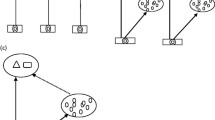Abstract
When Phagocata vitta, Crenobia alpina and Polycelis felina were exposed separately to each of seventeen potential invertebrate predators in the laboratory, only two stonefly species, Dinocras cephalotes and Perlodes microcephala, fed on the three triclad species, whilst the trichopteran Rhyacophila dorsalis ate the last two triclads. On exposing pairs of triclad species to D. cephalotes, significantly more P. felina than Ph. vitta were consumed, whereas similar numbers were eaten in each of the other two triclad combinations. Cannibalism and interspecific predation by triclad species were not observed. It is concluded that predation is unlikely to have a major influence in determining the observed distribution and abundance of triclad species in a Welsh study stream which harbours low numbers of effective predators.
The de Wit model of competition was used to examine the competitive relationships between Ph. vitta, and C. alpina and P. felina, using chironomids or tubificid worms as food. In mixed cultures of Ph. vitta and P. felina fed on tubificids a stable equilibrium existed within the range of relative densities used in the experiments, whereas Ph. vitta was competitively superior to C. alpina in cultures fed on each of the food types, and to P. felina fed on chironomids. However, in theory, an equilibrium could occur when 10 or 6–7 times as many Ph. vitta as P. felina and C. alpina respectively are in the culture, when intraspecific rather than interspecific competition would become more important. Where the three triclad species coexist in the Welsh study stream, they are in similar numbers. This could imply that food is not limiting, with no consequent interspecific competition, or that the laboratory experiments were too simplistic to allow any interpretation of the field situation.
Similar content being viewed by others
References
Armitage, M. J., 1988. The ecology of the freshwater triclad Phagocata vitta. Unpublished Ph. D. thesis, University of Liverpool.
Armitage, M. J. & J. O. Young, 1990. The realised food niches of three species of stream-dwelling triclads (Turbellaria). Freshwat. Biol. 24: 93–100.
Begon, M., J. L. Harper & C. R. Townsend, 1986. Ecology. Individuals, populations and communities. Oxford: Blackwell Scient. Publ.
Davies, R. W., 1969. Predation as a factor in the ecology of triclads in a small weedy pond. J. anim. Ecol. 38: 577–584.
Davies, R. W. & T. B. Reynoldson, 1971. The incidence and intensity of predation on lake-dwelling triclads in the field. J. anim. Ecol. 40: 191–214.
Lock, M. A., 1972. The responses to current flow of two stream dwelling triclads, Crenobia alpina (Dana) and Polycelis felina (Dalyell). Oecologia Berl.) 10: 313–320.
Lock, M. A. (1975). An experimental study of the role of gradient and substratum in the distribution of two stream-dwelling triclads, Crenobia alpina (Dana) and Polycelis felina (Dalyell) in North Wales. Freshwat. Biol. 5: 211–226.
Lock, M. A. & T. B. Reynoldson, 1976. The role of interspecific competition in the distribution of two stream dwelling triclads, Crenobia alpina (Dana) and Polycelis felina (Dalyell), in North Wales. J. anim. Ecol. 45: 581–592.
Reynoldson, T. B., 1966. The distribution and abundance of lake-dwelling triclads — towards a hypothesis. Adv. Ecol. Res. 3: 1–71.
Reynoldson, T. B., 1983. The population biology of Turbellaria with special reference to the freshwater triclads of the British Isles. Adv. Ecol. Res. 13: 235–326.
Sigurjonsdottir, H. & T. B. Reynoldson, 1977. An experimental study of competition between triclad species (Turbellaria) using the de Wit model. Acta Zool. Fenn. 154: 89–104.
Townsend, C. R., 1989. The patch dynamics concept of stream community ecology. J. N. Am. Benthol. Soc. 8: 36–50.
Wit, C. T. de, 1960. On competition. Vers 1. landbouwk. Onderz. ned. 66: 8.
Wit, C. T. de, 1961. Space relationships within populations of one or more species. In F. L. Milthorpe (ed.), Mechanisms in biological competition. Symp. Soc. Exp. Biol. 15: 314–329.
Wit, C. T. de, 1971. On the modelling of competitive phenomena. In P. J. den Boer & G. R. Gradwell (eds.), Dynamics of populations. Centre Agric. Publ. Docum., Wageningen.
Wright, J. F., 1972. The distribution of stream-dwelling triclads (Platyhelminthes) in North Wales. Freshwat. Biol. 2: 57–64.
Wright, J. F., 1974. Some factors affecting the distribution of Crenobia alpina (Dana), Polycelis felina (Dalyell) and Phagocata vitta (Dugès) (Platyhelminthes) in Caernarvonshire, North Wàles. Freshwat. Biol. 4: 31–59.
Wright, J. F., 1975. Observations on some predators of stream-dwelling triclads. Freshwat. Biol. 5: 41–50.
Author information
Authors and Affiliations
Rights and permissions
About this article
Cite this article
Armitage, M.J., Young, J.O. Predators and planariid competitors of the triclad Phagocata vitta (Dugés). Hydrobiologia 211, 43–50 (1991). https://doi.org/10.1007/BF00008615
Received:
Revised:
Accepted:
Issue Date:
DOI: https://doi.org/10.1007/BF00008615




